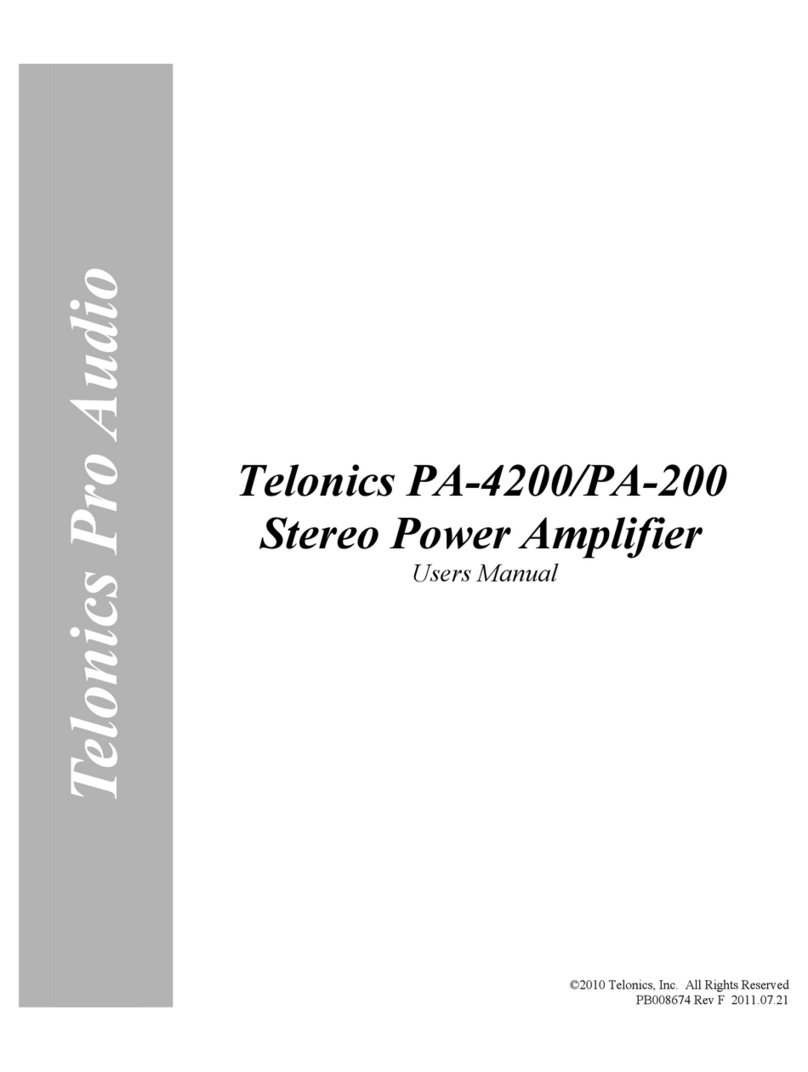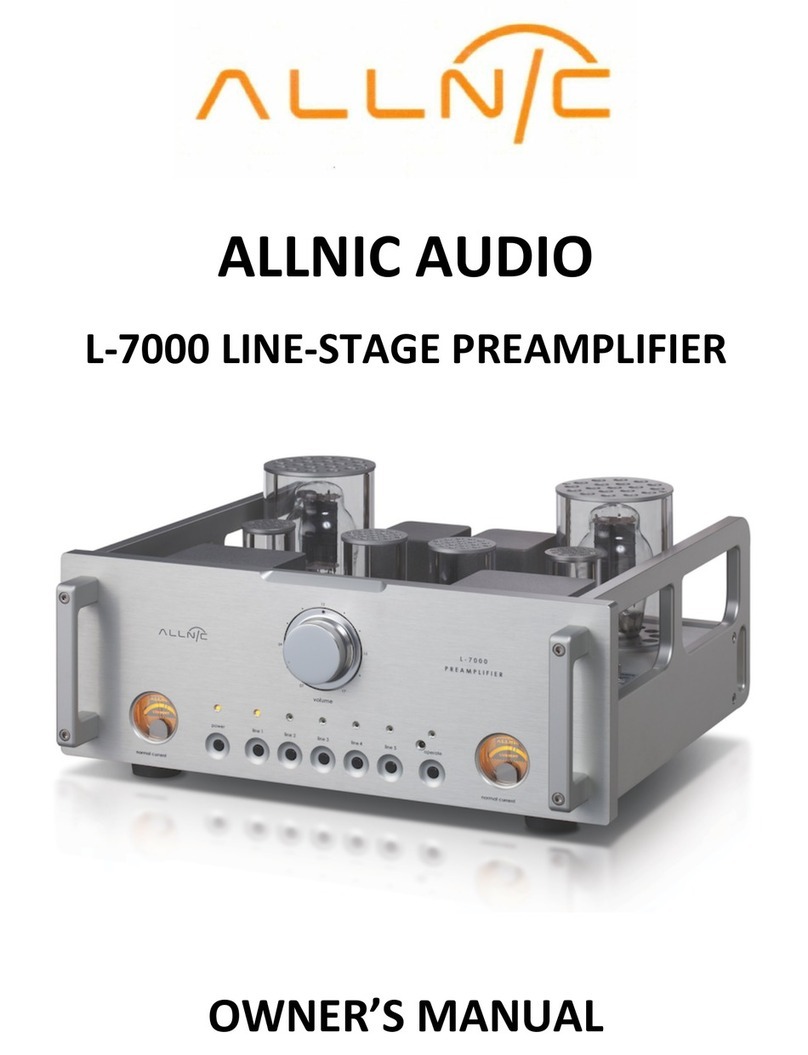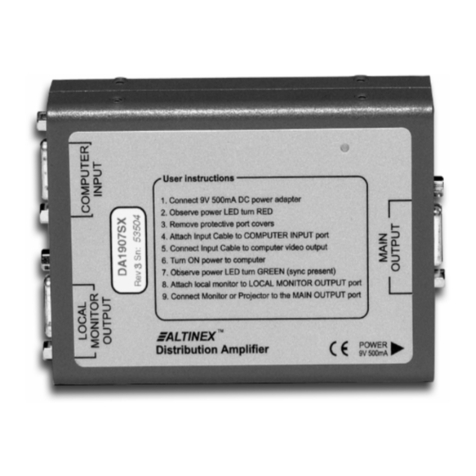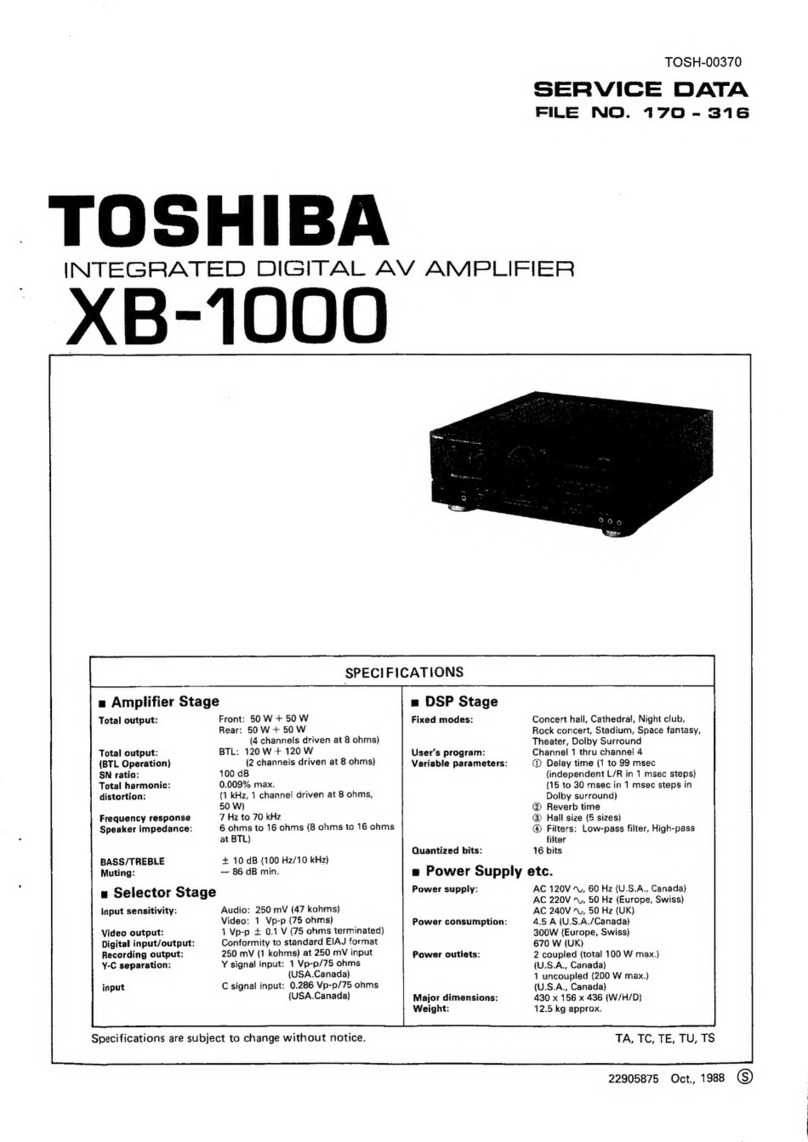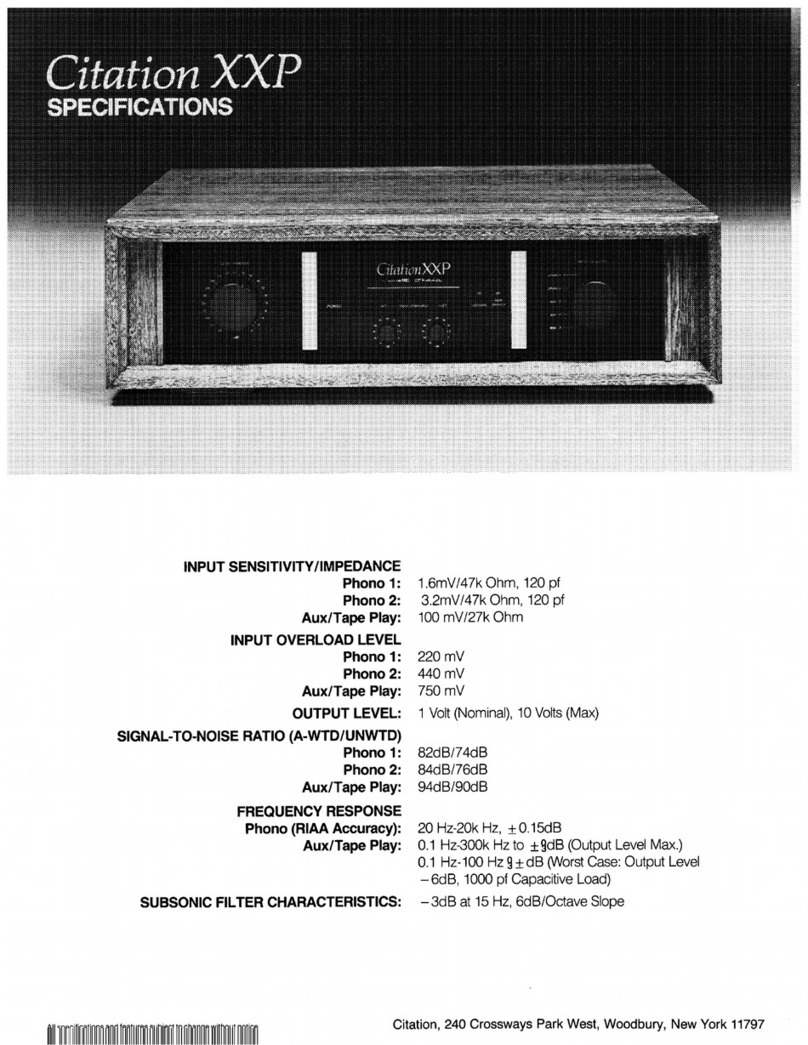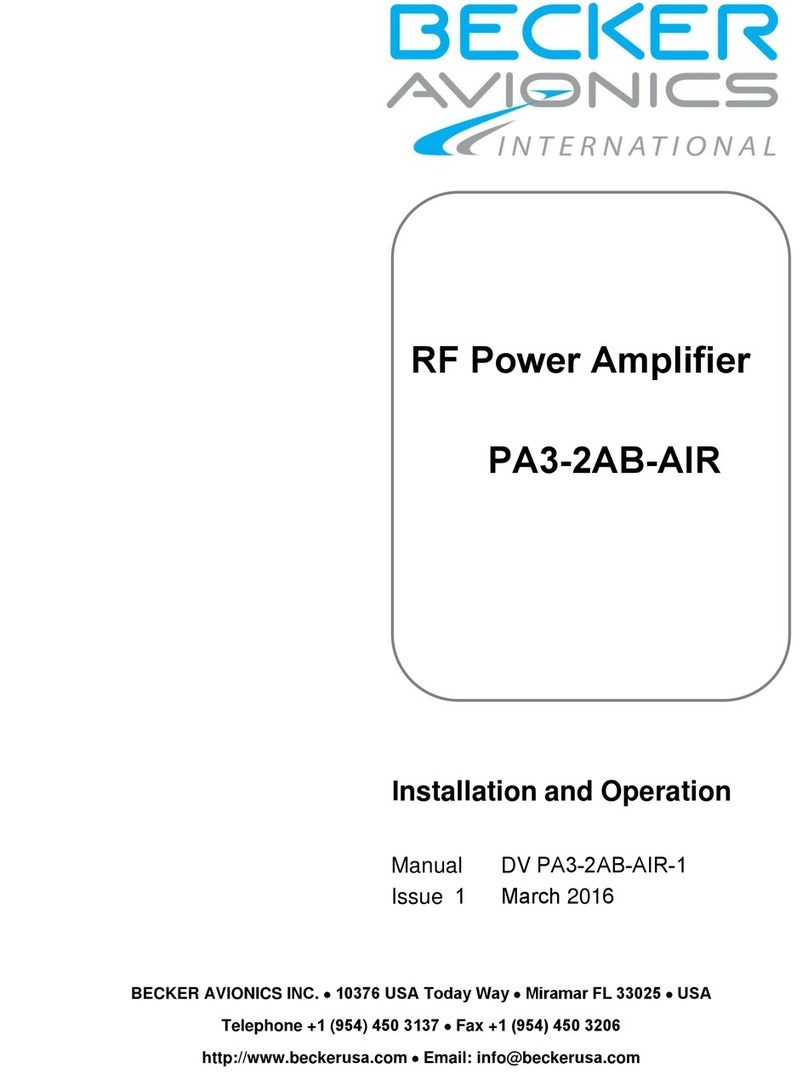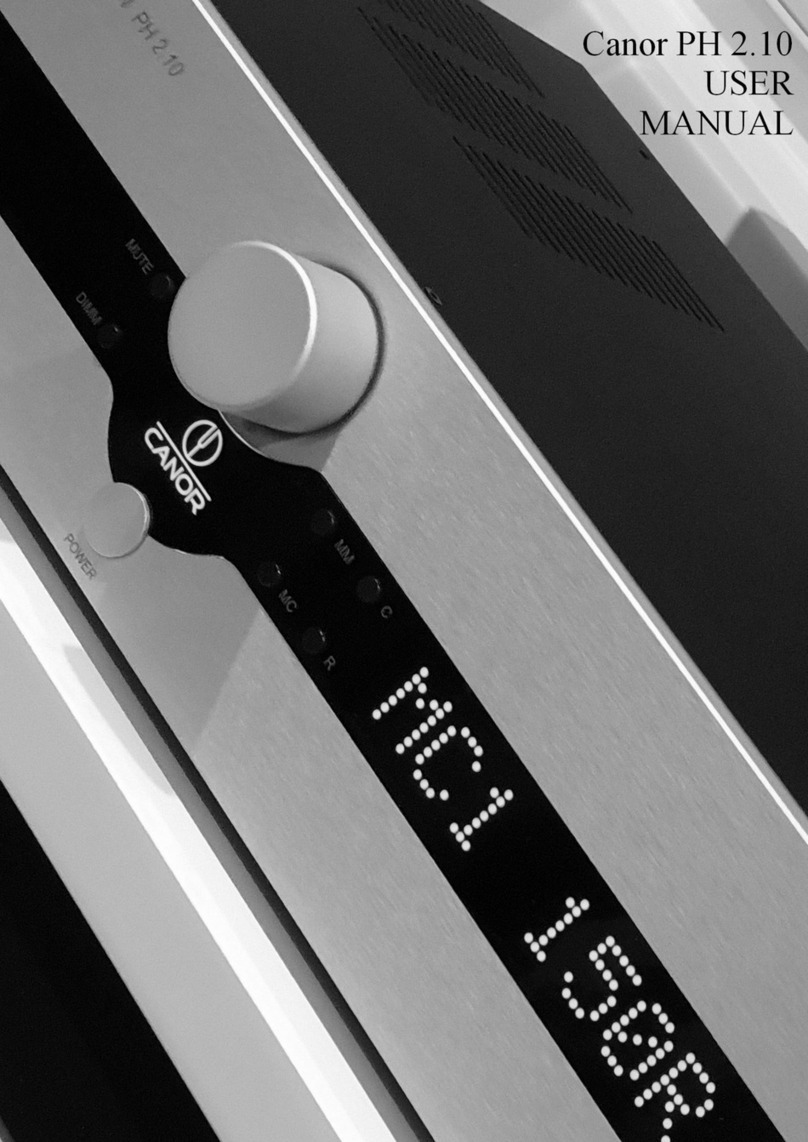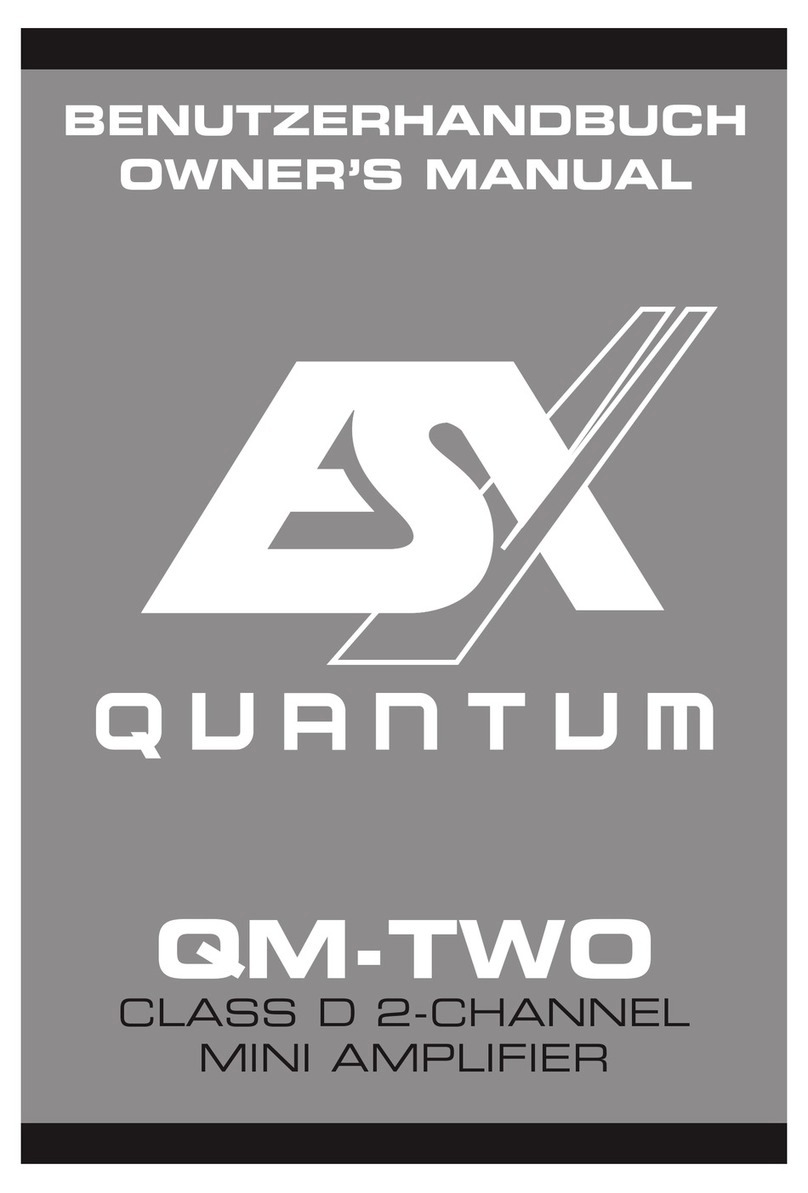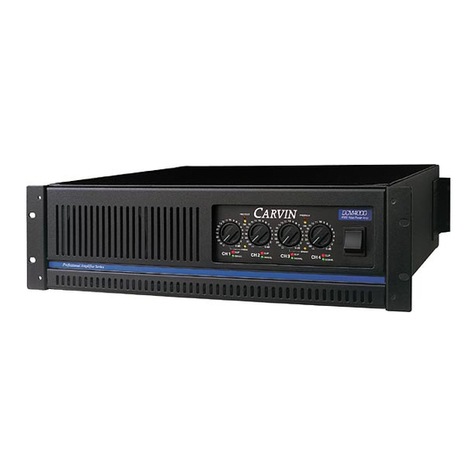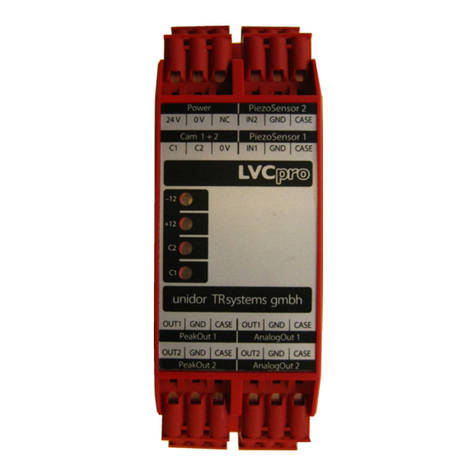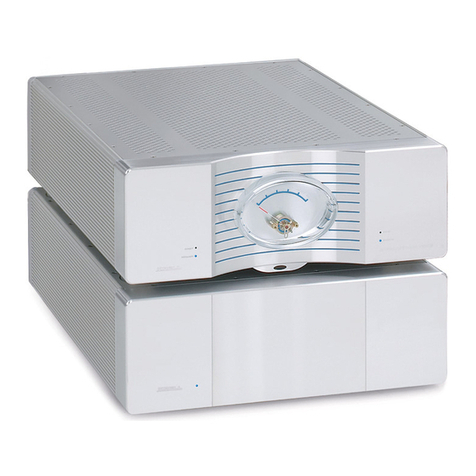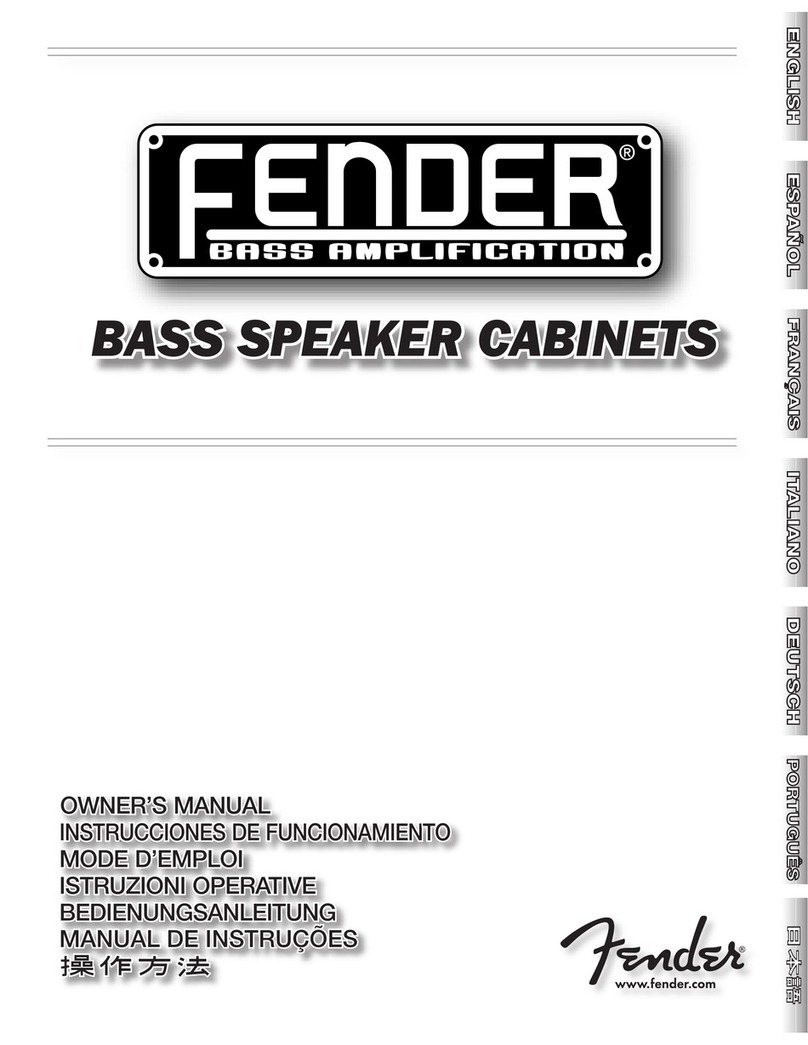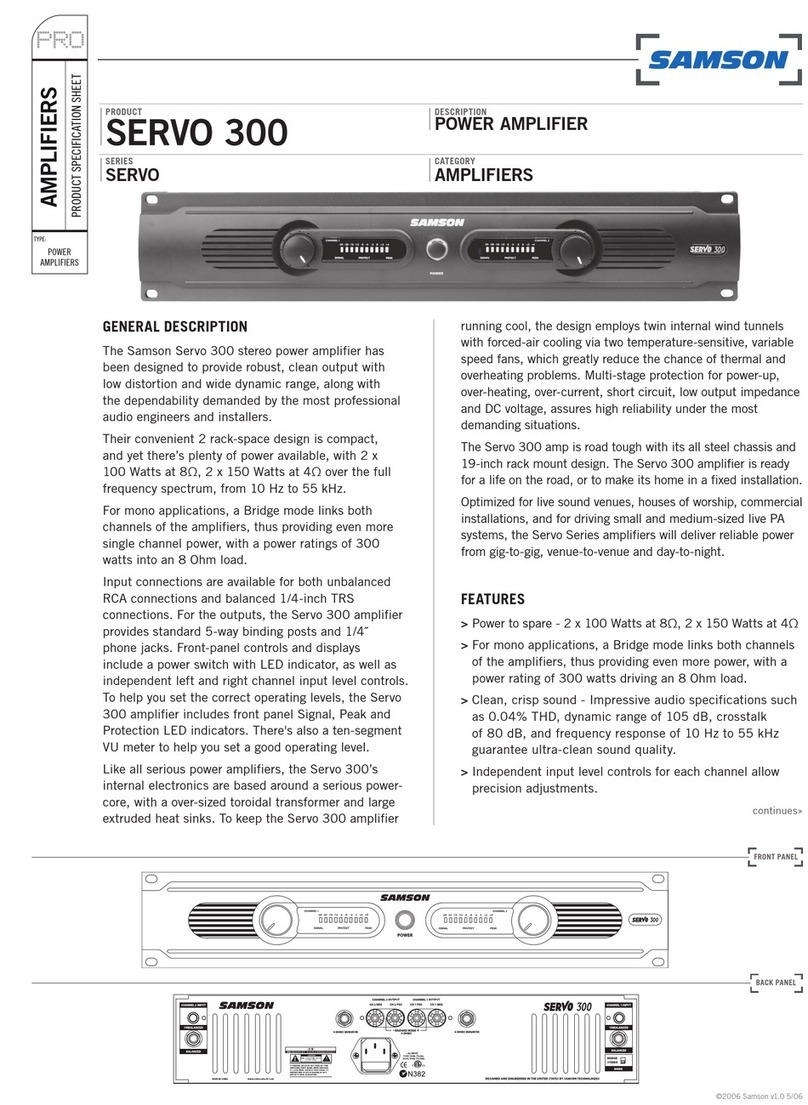Telonics TCA-500 User manual

User Manual
Telonics TCA-500
Combo Amp
©2014 Telonics, Inc. All Rights Reserved
PB-009289 Rev _ PR LIMINARY 2014.04.11

Telonics TCA-500 Combo Amp
2
PB-009289 Rev _ PRELIMINARY
CAUTION Risks of electrical shock – DO NOT OPEN
CAUTION To reduce the risk of electric shock, do not remove from cabinet. No user serviceable
parts inside. Refer Servicing to qualified service personnel.
WARNING To prevent electrical shock or fire hazard, do not expose this appliance to rain or
moisture. Before using appliance, read the operating guide for further warnings.

Telonics TCA-500 Combo Amp
PB-009289 Rev _ PRELIMINARY
The Telonics TCA-500
F
RONT
P
ANEL
(BLAC AND WHITE OPTION SHOWN)
R
EAR
P
ANEL
Congratulations on purchasing one of the world’s finest professional instrument combo
amplifiers! The TCA-500 combo amplifier is a state of the art audiophile quality unit designed
and built with the latest and best sounding technologies. It has been carefully engineered to
provide every function and convenience possible within its cost/benefit ratio, for the professional
musician. There is a reason for every function provided. The user is encouraged to read this
manual in order to achieve the highest level of performance provided by these capabilities.
The TCA-500 combo amplifier gives you dramatically better control of your sound. The result is
transparent smooth clean sound, tight bottom end and silky highs. It is designed to accommodate
many different instruments and as such, its controls cover a wider range of options than
previously offered to the professional musician. Accordingly, for any given instrument, the
controls may ‘feel’ more sensitive when adjusted for a specific instrument. For this reason, the
user is encouraged to make smaller adjustments while listening carefully. Final adjustments
should always be made with the ear, without regard to where one “expects” the knob to be.
Telonics TCA-500 Combo Amp Features:
• Superb string separation at all volume levels. No muddiness!
• All pure analog, main signal chain. No digitization of your sound thru A/D or D/A
converters.
• Pre Q Insert for Q or 3-wire Pot Pedal hook-up.
• Warm tube-like, even-order harmonic sound with crystal clear highs.
• Ultra low noise – studio quality.
• xceptionally high headroom.
• High output level available on demand.
• 500 Watt Power Amp section.
• Studio Pre- Q parallel effects loop with adjustable S ND and R TURN levels to
accommodate any FX unit(s) (rear panel mounted).
• Built in electronic reverb with front panel level control and remote control jack.

Telonics TCA-500 Combo Amp
4
PB-009289 Rev _ PRELIMINARY
T
ELONICS
TCA-500
C
OMBO
A
MP
F
EATURES
:
(C
ONTINUED
)
• Overload L D indicator.
• Master Wet/Dry fader control – controls internal effects and parallel FX loop.
• Built-in “TBro” effect with remote control jack.
• Pedal Switch jack on rear panel allows switching “TBro” and Reverb remotely.
• Special “Blend” Q control for personalizing your tone or adjusting for venue. (Once
properly adjusted, Master volume and Blend are generally the only adjustments used).
• Auxiliary AC power outlet, switched with main power switch.
• Special Power On/Off circuit to minimize “pops” and speaker damage.
• Built in high output headphone amp with separate volume control.
• Super quiet Mute circuit with L D indicator.
• Digital Thermal Management System.
• 24 volt DC jack to power Telonics 24 VDC FP-100 foot pedal.
• Balanced XLR Direct stereo output for stage and studio use. Includes ground lift switch.
• Analog modeling for Direct Out for live venue or studio use, with preset modeling.
• Buffered tuner output (jacks on both front and rear panels) - active full-time, even when
mute is ON.
• Auxiliary stereo input (on rear panel) for home practice or solo gigs with front panel level
control. For CD/mp3 players or for use as a second effects R TURN. Also routed to DI
for recording.
• Front Mounted Power Amplifier On/Off switch for preamp-only use in Studio.
• Highest Quality Telonics N O Speaker (12 or 15 inch).
• 1U rack space provided which may be used for FX Units, tuners, etc.
• Built-in cabinet-wide L D lighting for low light venues with back panel switch to control
On/Off and brightness level.
• Highly abrasion-resistant outer surface, durable Baltic Birch plywood construction
throughout. Made for years of trouble free use.
• International versions available for export.
• Proudly made in the U.S.A. by musicians and engineers.

Telonics TCA-500 Combo Amp
5
PB-009289 Rev _ PRELIMINARY
TCA-500
C
OMBO
A
MP
C
ONTROL
F
UNCTIONS
,
J
AC S
,
&
I
NDICATORS
:
F
RONT
P
ANEL
24VDC Output
This socket provides an isolated 24 volts DC to power up the FP-100 foot pedal.
It accepts a special twist lock plug for a secure connection of power to the pedal.
A power lead with locking connectors is supplied with the TCA-500 Amplifier.
Input High impedance (1Meg Ohm) instrument input - will not load down your guitar
pickup or adversely affect your tone. It accepts a standard 1/4 inch type TS plug
for guitar level signals.
Input Gain
and
Red Overload
LED
This control sets the gain for the first amplification stage. And is used in
conjunction with the MAST R L V L control, it also affects the level for the
Pre Q Pedal insert To/Send” jack and the maximum level to the EFX Send
jack (both of which are on the rear panel). Start at 3 or 4 and adjust as needed.
It’s important to understand the function of this control as its setting
impacts other controls and the overall sound. When a guitar signal is fed
into the amplifier, it is necessary to increase the signal level to minimise
noise that might be added in the following stages. Typically, guitar pickups
with a high output require a lower gain setting and pickups with a low
output required a higher gain setting.
In the lower right-hand corner of the Input Gain box is a red (Input/ Q
Overload) L D that indicates an overload is occurring in the pre-
amplifier stage. If this L D flashes on frequently, or stays on while the
guitar is played, the Input Gain is setting is too high and should be
reduced in order to avoid distortion of your sound.

Telonics TCA-500 Combo Amp
6
PB-009289 Rev _ PRELIMINARY
TCA-500
C
OMBO
A
MP
C
ONTROL
F
UNCTIONS
,
J
AC S
,
&
I
NDICATORS
:
F
RONT
P
ANEL
(
CONTINUED
)
Input Gain
and
Red Overload
LED
(continued)
The following text describes how the Input Gain should be set with a
typical arrangement:
i) We assume that in most cases, the output of your guitar connects to
your volume pedal input and the output of your volume pedal connects
to your amplifier (Note; always use good quality leads for these
connections and try to ensure they’re no longer than they need to be to
reach the jacks. Make sure they are not a trip hazard).
ii) With the Master Level control set to 1, your volume pedal set to
maximum and Input Gain control set to 1, play some nice big chord
groups slightly harder than you ould normally play; slo ly increase
the Input Gain control until the Overload LED just starts to occasionally
flash, then reduce the Input Gain control until it ‘just’ ceases to flash as
you strike the chords.
iii) You have no set the optimum level for the Input Gain control. You
should not need to adjust the Input Gain control unless you change
your guitar or volume pedal. We suggest you note this setting.
A common mistake is to see players using the Input Gain to control
output volume. The problem with this is the Input Gain control
affects the level sent to the effects unit.
Always use the Master Level to control output volume after the
Input Gain control has been adjusted as outlined above.

Telonics TCA-500 Combo Amp
7
PB-009289 Rev _ PRELIMINARY
TCA-500
C
OMBO
A
MP
C
ONTROL
F
UNCTIONS
,
J
AC S
,
&
I
NDICATORS
:
F
RONT
P
ANEL
(
CONTINUED
)
Bass Level Controls low frequency response. Turning clockwise will boost the bass up to
+22dB. Turning counter clockwise will decrease the level down to -16dB.
Start at 0 (flat) and adjust to taste.
Note that it is a common error to boost the bass excessively, as this dulls the
character of the strings. Remember that it is always best to use “Subtractive
qualization” as discussed later in this manual. i.e., instead of boosting the Bass,
reduce the Mids and/or Treble. A simple check for excessive bass boost is to
listen closely as you strike a lower string repeatedly. Start with the Bass Level
control set at -4 or -5. While listening to the character of the string, advance the
Bass Level control slowly clockwise. At some point (usually around +1 to +3, the
character of the sound will change and will sound like more of a “thud” and have
a muted quality. For most people, that is too much bass boost, so back off the
control counterclockwise slightly until the sound is once again clear and clean.
Mid Level It is necessary that the user understand that the Mid Level and Mid Frequency
controls work ‘together’. These two controls are used together to set up the
mid range frequency shaping; they are perhaps the most important tone
shaping controls and they ‘must’ be set properly to achieve a balanced
sound. These controls allow the player to compensate for the ear’s normal
increase in sensitivity to mid range frequencies and the guitar’s resonance
around those frequencies.
The Mid Level control determines the amount of effect which the Mid Frequency
control has on your sound.
It sets a boost or cut in the mid-range frequencies, which are selected by the Mid
Frequency control. Mid Level is adjustable from -20dB cut to +5dB boost.
If you were to set the Mid Level control to Zero dB (3 o’clock knob position), the
Mid Frequency control would ‘do nothing whatsoever” to your sound, it would
have NO effect on your tone.
.

Telonics TCA-500 Combo Amp
8
PB-009289 Rev _ PRELIMINARY
TCA-500
C
OMBO
A
MP
C
ONTROL
F
UNCTIONS
,
J
AC S
,
&
I
NDICATORS
:
F
RONT
P
ANEL
(
CONTINUED
)
Mid Level
(continued)
Since the mid-range frequencies are tiring to the human ear, it is almost always
necessary to CUT or reduce them. The Mid Frequency control allows the user to
choose the center frequency at which the mid frequencies are reduced, to suit his
or her ear.
The following text describes how the Mid Level and Mid Freq
controls should be set for steel guitar:
i) We assume the Input Gain control has already been set. Set the Bass
Level control to 0, the Treble Level control to 0, the Blend control to 0
and the Master Level control to 2. All effects should be OFF.
ii) No set the Mid Level control fully clock ise (+5) and set the Mid Freq
mid ay (600 Hz). Note hen you pick a string the Overload LED may
flash; don’t adjust the Input Gain control. Note that the overload
monitoring circuitry monitors both the output of the gain section and
the EQ section; because e’ve set the Mid Level control to full boost it
causes the overload.
iii) Ensure the combo speaker is pointed to ards your ear. Pick one or t o
strings in the center string grips and slide the bar over the normal
range of the fret board you ould use. As you are doing this, t eak the
Mid Freq control up and do n around the 400 to 800 region; it’s handy
to have a friend rotate the Mid Freq control as you play. At one point
over the region you might possibly notice, no matter here you are on
the fretboard, a ‘honky’ midrange sound is heard that’s a little
unpleasant on the ear. It does take practice and time to learn ho to
detect this point, so don’t be concerned if it’s not clear the first time
you attempt this. Note the Overload LED may help detect this point,
quite often it flashes more as you hit area’s here’s there’s more
resonance.
Once you have found the honky, excessive ‘middle’ sounding frequency,
rotate the Mid Level control to around the 10 o’clock position (-12dB). As
you play your guitar tweak the Mid Level control up and down around this
point until it sounds balanced in the mid range. Generally, the most
suitable setting is between -15 dB and -12 dB for most people. Don’t
worry about setting the bass and treble controls until you’re happy that the
mid range is the best it can be.
Always, Always, make the above adjustments with the Bass and treble
controls at zero.
Mid Frequency Sets the frequency at which the Mid Level control has an effect. Several
frequency intervals between 375 Hz and 1400 Hz are marked. Its effect is
determined by the setting of the Mid Level control. Proper adjustment is achieved

Telonics TCA-500 Combo Amp
9
PB-009289 Rev _ PRELIMINARY
as outlined above.
Treble Level Adjusts the high frequency level of the sound generated by your instrument. Start
at 0 (flat) and adjust to taste. Turning clockwise boosts the level of highs up to
+16dB, turning counterclockwise cuts the level of highs down to -16dB.
Note: We always recommend using the minimum amount of bass and
treble tone shaping to achieve the sound you desire. These controls
are very powerful; they can greatly cut or boost the gain of the lower
and higher frequencies. If an extreme setting of this control is
required to achieve a balanced sound you may have an issue with
your Mid Level and Mid Frequency control settings, or, with your
guitar pickup, leads, volume pedal.
After setting the Bass Level, Mid Level, Mid Freq and Treble Level
controls we suggest you note the settings.
Blend
Only set this control after you have set
all
the o
ther
tone control
s.
This is to
be used as a sonic “shading” control and, like any seasoning, a little goes a long
way. Start at 12 o’clock. Clockwise yields a “Mooney” bright aggressive sound;
counter clockwise gives you a mellow, darker tone.
The Blend control is initially one of the most confusing settings to
understand… until you start using it. After using the combo for a few
gigs you may find it’s the only tone control you need! Once the bass,
mid and treble controls have been set the amplifier might be
considered as calibrated to your style and guitar sound.
As you rotate the Blend control clockwise you’ll notice the treble
increases and the bass decreases.
As you rotate the Blend control anti-clockwise you’ll notice the
treble decreases and the bass increases.
This control is like ‘one stop shop’ compensating for the affect the room
acoustics has on the overall sound. It’s quite remarkable how a small
tweak of this control can sweeten up your sound in a gigging situation.
And being a single control it’s easy to remember where you started before
you started tweaking.
Normally, players leave this control at zero and only adjust it slightly
between +1 or -1 to compensate for the venue (room size, crowd size,
bandstand configuration (even for relative humidity changes, as sound
propagates differently with humidity changes).

Telonics TCA-500 Combo Amp
10
PB-009289 Rev _ PRELIMINARY
TCA-500
C
OMBO
A
MP
C
ONTROL
F
UNCTIONS
,
J
AC S
,
&
I
NDICATORS
:
F
RONT
P
ANEL
(
CONTINUED
)
Master Level Sets the overall output level of the Combo Amp. Adjust this after you have set
the Input Gain and Q. This is your main volume control knob – to be adjusted as
necessary as you play a gig. For normal size venues, the customary range is
between 6 and 8 or less.
The Master Level control sets the overall signal level sent to the power
amplifier (PA). Adjustment of this control will not affect the Direct Out
level. This allows players to adjust their own stage level without
affecting the signal level sent to the mixing desk – a handy feature!
BRO This switch will activate a “TBro” type effect. The green “TBro” ‘ON’L D will
light when TBro is active. The Foot Switch connector on the rear panel can be
used to turn the TBro function Off and On if the TBRO pushbutton switch on the
front panel is pushed On (in). If either this switch or an external switch is in the
Off position, the effect will remain Off. (When an external/remote switch is not
used, the default is On. (See back panel Foot Switch)
An optional remote switch box for steel guitar (and a remote foot switch for other
instruments) is available for rapid remote control of the TBro and Reverb
functions. The usage of these optional accessories is outlined later in this manual.
Reverb Level –
Rev ON button
The Reverb Level control determines how much of the internal reverb signal is
applied to the Wet/Dry Fader control. The input level to the reverb circuit is
affected by the Input Gain control level (as mentioned earlier). The reverb input
is a combination of the dry input after the EQ controls and the Post EQ EFX
Return signal (rear panel).

Telonics TCA-500 Combo Amp
11
PB-009289 Rev _ PRELIMINARY
TCA-500
C
OMBO
A
MP
C
ONTROL
F
UNCTIONS
,
J
AC S
,
&
I
NDICATORS
:
F
RONT
P
ANEL
(
CONTINUED
)
Reverb Level –
Rev ON button
(continued)
The Rev switch will activate the internal reverb circuit. The green L D will light
when the reverb is active. The Foot Switch connector on the rear panel can be
used to turn the internal reverb Off and On if the Rev pushbutton switch on the
front panel is pushed On (in). If either this switch, or an external switch, is in the
Off position, the reverb will remain Off. When an external remote switch is not
used, the default is On. (See back panel Foot Switch)
The built-in reverb is useful if you don’t have an effect processor installed.
It can be switched On/Off from the front panel using the Rev ON button or
by remote control using the Footswitch jack on the rear panel. The reverb
sound has been preset to a general ambience algorithm; the Reverb Level
control adjusts the amount of reverb introduced.
The built-in reverb signal is added to the signal returning from the
FX Return jack that feeds the Wet side of the DRY/W T Fader.
This means, the DRY/W T Fader must have a proportion of Wet
signal set or the built-in reverb will not be heard. i.e. if the
DRY/W T Fader is set fully Dry no reverb will be heard.
If the TCA-500 is used with a 19” rack effects processor, (such as a
Lexicon MX-200, a T.C. lectronics G-Major/II, or other 1U space multi-
effects unit), we would recommend the built-in reverb be turned off and
patches set up on the effects processor; the reverb algorithms of a good
quality effects processor should be superior to the built-in reverb.
1U 19” Rack Space – The TCA-500 has a built in rack space below
the main amplifier chassis. If no effects processor is fitted in this
space a blanking plate should be fitted. On the rear panel an I C
switched outlet is provided to power up the effects processor; 50W
max. Although the general thought behind providing this space is to
enhance the reverb and delay effects, almost any 1U unit no more
than 8 inches or 200mm deep could be installed in this space.

Telonics TCA-500 Combo Amp
12
PB-009289 Rev _ PRELIMINARY
TCA-500
C
OMBO
A
MP
C
ONTROL
F
UNCTIONS
,
J
AC S
,
&
I
NDICATORS
:
F
RONT
P
ANEL
(
CONTINUED
)
Reverb Level –
Rev ON button
(continued)
An optional remote switch box for steel guitar (and a remote foot switch for other
instruments) is available for rapid remote control of the TBro and Reverb
functions. The usage of these optional accessories is outlined later in this manual.
A TRS three-conductor coaxial cable is necessary to connect most multi-effect
units to an external control box or foot pedal.
DRY/WET Fader This fader controls the ratio of “dry” (without effects) and “wet” (with effects)
signals sent to the Master Level control. Counter clockwise is dry, clockwise is
wet.
DRY/WET FADER – EFX SEND + LEVEL (rear panel) - EFX
RETURN + LEVEL (rear panel) – The Dry/Wet Fader and rear panel
effects loop is a very powerful feature that allows effects to be added to
the analog signal chain in a number of ways.
The level sent out to the effects unit can be adjusted using the FX Send
Level on the rear panel. This is adjustable to drive effect inputs from, -
30dB to +4dB ; the +4dB setting generates the highest output. It’s very
important to ensure the TCA-500 Overload L D just starts to blink
B FOR the effects processor input level reaches its maximum input
level or clipping point. The average user can easily ensure the correct
and proper FX send level by looking up the preferred level in the
manual for the appropriate multi-effects units and setting the FX
R TURN and FX S ND controls on the TCA-500 to specified levels.
Normally these levels will be -10 dBu, -8 dBu, -4 dBu, 0 dBu or +4
dBu. The TCA-500 provides the ability to match virtually any high
quality FX units.
The level returned from the effects unit can be reduced or boosted using
the FX Return Level on the rear panel. This is adjustable over the
range from, -30dB to +4dB ; the +4dB setting applies the highest gain
to the returned signal. This level should be adjusted so the effects
processor output doesn’t cut or boost the signal; we call this ‘unity’
gain. A good way to check this is to set the effects processor to
‘bypass’: Then set the DRY/W T Fader fully Wet and then fully Dry,
you should notice virtually no change in volume; adjust the FX Return
Level to achieve this.

Telonics TCA-500 Combo Amp
1
PB-009289 Rev _ PRELIMINARY
TCA-500
C
OMBO
A
MP
C
ONTROL
F
UNCTIONS
,
J
AC S
,
&
I
NDICATORS
:
F
RONT
P
ANEL
(
CONTINUED
)
DRY/WET Fader
(continued)
Your effects send and return levels should now be optimised. We
suggest you note the settings.
Series Effects Loop Mode
By setting the Dry/Wet Fader fully Wet, mono effects can introduced in
a series chain. i.e. all of the signal passes through the effects loop and
no thru signal is added to the effected signal. This mode is useful where
compression or modulation effects need to be added.
Most effects processor manufacturers recommend series mode, there is
however a down side when using effects processors as part of series
chain. To generate high quality effects requires complex mathematics
and powerful processors, and time to perform the calculations. This
introduces a small delay as the signal passes through the effects
processor; this delay is called ‘latency’. A high performance processor
like the T.C. lectronics G-Major/2 introduces a delay of about 1.6
milliseconds into the signal chain.
If you consider reverb or delay effects this latency has negligible effect,
as the effect you are using is in fact delay based itself. But in a series
chain effect arrangement the straight through signal will also be delayed
by 1.6 milliseconds. There is considerable debate whether or not this
delay can be detected by the player. In tests we’ve carried out,
comparing series and parallel effects patches, it is our opinion that it is,
in fact, detectable by some players.
For this reason we would therefore not recommend using effects
processors in a series mode that introduce latency.

Telonics TCA-500 Combo Amp
14
PB-009289 Rev _ PRELIMINARY
TCA-500
C
OMBO
A
MP
C
ONTROL
F
UNCTIONS
,
J
AC S
,
&
I
NDICATORS
:
F
RONT
P
ANEL
(
CONTINUED
)
DRY/WET Fader
(continued)
Parallel Effects Loop Mode
By setting the Dry/Wet Fader at a mid-way point, the dry or thru signal
will be mixed with the effected signal. Typically a 12 o’clock position is
a good starting point.
The FX Return Level should be adjusted so the effects processor adds
a typical effect level when the Dry/Wet Fader is in the 12 o’clock
position. Note the effects processor patch settings will also affect this
level; good noise / headroom practice must be considered when
developing patches.
In parallel mode the dry or thru signal is passed within the TCA-500
and only the effected signal is returned by the effects processor. When
developing patches for parallel mode use, it is essential that the effects
processor is not allowed to pass an unaffected or straight through signal.
If this occurs, the true thru signal will mix with the latency delayed thru
signal and generate a modulated dry signal. This might in some
situations sound nice while setting up the patch, but in a gigging or
recording situation this often corrupts the general Q, messing up the
natural sound of the instrument.
A well configured parallel effects loop, with a suitably configured delay
and reverb effect only being returned, enhances the natural sound of the
steel guitar and most other instruments. The T C lectronics G-Major/2
effects processor has some suitable routings with good control of both
the effect mix and effect level, for both delay and reverb. A number of
patches have been developed for this unit to be used with the TCA-500.
The ability to adjust the Dry/Wet Fader to control the effects level in a
live gigging situation is another advantageous feature of parallel mode.

Telonics TCA-500 Combo Amp
15
PB-009289 Rev _ PRELIMINARY
TCA-500
C
OMBO
A
MP
C
ONTROL
F
UNCTIONS
,
J
AC S
,
&
I
NDICATORS
:
F
RONT
P
ANEL
(
CONTINUED
)
Direct Out
Level – Gnd Lift
This level adjustment will allow you to match the DO signal you are sending, to
the proper level required by the mixer board or recording device. Most line level
devices are either +4dB or -10dB. You can adjust for either, however, you can
also adjust your Direct Output signal low enough for microphone inputs
with below -30dB adjustment- this is an unusual capability. This allows you
to use your high quality balanced XLR Direct Output with low end mixer
boards which only provide mic level inputs. (A very handy capability when
you walk into a new venue cold and have no idea what the sound person
might have to work with.)
The DO in the TCA-500 is analog modeled to deliver to a flat response
system, a very closely EQ’d approximation to what is output from the combo
speaker in its cabinet.
The signal sent from the XLR connection is balanced line and male
gendered (standard XLR out). The GND Lift pushbutton allows the
combo earth to be separated from the DI earth to assist with hum ground
loop issues. The front panel Direct Level control allows the signal sent
to the desk/house board to be easily adjusted over a wide range.
Note; when the PA ON (Power Amp On/Off) button is Off (i.e. no
sound is output from the combo speaker, but the headphones output is
still active), the DO output remains ON because the preamplifier section
is ON.

Telonics TCA-500 Combo Amp
16
PB-009289 Rev _ PRELIMINARY
TCA-500
C
OMBO
A
MP
C
ONTROL
F
UNCTIONS
,
J
AC S
,
&
I
NDICATORS
:
F
RONT
P
ANEL
(
CONTINUED
)
Aux Level
(Stereo)
The Auxiliary level control is used to set the level of background/track music
from .MP3 players, CD players or other audio sources.
It can also be used as a second effects R TURN. If used as second effects return,
the Tuner Out on the rear panel can be used as effects S ND. See FAQ sheet.
This input accepts a standard ¼ inch TS or TRS plug. Most .MP3 players require
a 1/8 inch TRS plug. Accordingly, a 1/8 inch-to-1/4 inch TRS cable is supplied
with the TCA-500. Some CD players still utilize separate RCA jacks and
therefore require a dual RCA plug (male) to ¼ inch TRS plug cable. These are
readily available to most home entertainment electronics stores and are generally
stocked at Telonics as well.
As such, the Auxiliary Input is not designed for low-level instrument signals.
HOW V R, it may also be used as a second channel input from an external
source such as a preamp and/or effects chain. For example, a musician who
doubles on a second instrument might connect the output of a preamp,
compressor and/or other FX units following his instrument to the Aux input on
the rear panel of the TCA-500, thus providing for quick switching to a Tele,
MandoCaster, mandolin, or other instrument.

Telonics TCA-500 Combo Amp
17
PB-009289 Rev _ PRELIMINARY
TCA-500
C
OMBO
A
MP
C
ONTROL
F
UNCTIONS
,
J
AC S
,
&
I
NDICATORS
:
F
RONT
P
ANEL
(
CONTINUED
)
Headphone Gain Adjusts headphone output level. Turn down when not in use.
Headphone Jack The headphones output is a high level stereo ¼” TRS Jack output, capable
of driving headphones impedances of 8 Ohms or above.
WARNING – High headphone levels may damage your hearing
The Headphones Gain control allows the headphone output level to be
adjusted.
The Mute ON and PA ON switches do not affect the headphones output.
This unit puts out up to half a watt per channel into 8 ohms – more than enough
for any player at home. We recommend using quality headphones such as Sony
model MDR 7505.
Tuner Out Buffered output so it will not load down the pickup or the rest of the signal chain,
nor will it allow noise from the tuner to get back into the system. May be used
simultaneously with the Tuner Out jack on the rear panel. Output impedance is
approximately 500 ohms. These outputs are buffered for feeding to a guitar tuner.
The Mute ON switch does not affect these outputs; they are always ON.
Thermal
Management
Status
The Thermal Management Status indicates the temperature status of the power
amplifier. The L Ds indicate a low (green), medium (yellow), or high (red)
temperature range. (For more details see the Thermal Management System
section)
The L Ds will also indicate a fan speed out of specification condition as
described later, in the Thermal Management System; Fan Speed out of Spec
Indication paragraph.

Telonics TCA-500 Combo Amp
18
PB-009289 Rev _ PRELIMINARY
TCA-500
C
OMBO
A
MP
C
ONTROL
F
UNCTIONS
,
J
AC S
,
&
I
NDICATORS
:
F
RONT
P
ANEL
(
CONTINUED
)
Green LED The green L D will blink; On for a short time then Off, once a second while the
temperature is below the Low setting. This “wink” (short blink, once per second)
lets you know that the Thermal Management System is working. As the
temperature increases the green L D will come On solid while the temperature is
at or above the low setting.
Yellow LED The yellow L D will come On solid if the temperature is at or above the medium
set point.
Red LED The red L D will come On solid if the temperature is at or above the high set
point.
PA On Turns the power amplifier On and Off. A time delay is built into the audio
circuits to minimize “pop” when turning On or Off. Note: The preamp is still
operational when the PA is off.
The PA ON switches the combo Power Amp On/Off. It does not affect the
XLR Direct Out or the Headphones. When the PA ON switch is Off the
cooling fans are disabled to minimise noise for use in a studio.
Hint: If you ever find yourself at a live gig, trying to get sound from your
combo, but nothing is coming out, check this switch – someone may have
turned your power amplifier off!
AC On LED / AC
Switch
Main Power ON / OFF switch (rear) / AC ON LED (blue)
–
The AC
power switch is a small black “rocker” switch located above the AC power
cord I C connection point/socket on the rear panel. The blue AC On LED
on the front panel indicates AC mains power is applied and the AC Mains
Power switch is On.
Mute
MUTE ON switch / LED (yellow)
–
The Mute ON switch mutes the
output to the Power Amplifier, to the XLR Direct Out and to the PR
OUT; it does not affect the Headphone output, ffects Send and Pedal
TO outputs.
The Mute circuitry is designed to be super quiet when switched On and
Off. When the Mute is On the Yellow Mute LED is lit.
The Mute system in the TCA-500 is very handy for string replacement, practice
licks, tuning, and effects adjustment during live venue situations.

Telonics TCA-500 Combo Amp
19
PB-009289 Rev _ PRELIMINARY
TCA-500
C
OMBO
A
MP
C
ONTROL
F
UNCTIONS
,
J
AC S
,
&
I
NDICATORS
:
R
EAR
P
ANEL
AC (MAINS) Power
Input
110-120VAC input*. Standard C13 plug on a 18 AWG cord is recommended.
The power input is fused with an 8 amp 250VAC 5x20mm ceramic Slow Blow
fuse.
Main Fuse (rear) – The AC mains protection fuse is located on the
rear panel. It is in a fuse drawer directly above the AC mains power
cord socket and below the Off/On switch. Use a small screwdriver to
release the spring latch on each side of the drawer to release the fuse
drawer.
WARNING - Before checking this fuse ALWAYS ensure the
combo is disconnected from the mains supply.
If tests / a visual inspection of this fuse indicate it is open circuit,
take caution, your combo may have developed a fault.
ONLY replace the fuse with the XACT type – Ceramic 8 Amp :
5 x 20mm : 250 Volt.
Note: If the fuse should blow immediately after being replaced DO
NOT try it again, this could cause more damage; return the combo
to Telonics for testing and repair.

Telonics TCA-500 Combo Amp
20
PB-009289 Rev _ PRELIMINARY
TCA-500
C
OMBO
A
MP
C
ONTROL
F
UNCTIONS
,
J
AC S
,
&
I
NDICATORS
:
R
EAR
P
ANEL
(
CONTINUED
)
Front LED Light The Front L D Light switch is a three-position toggle switch which turns the
Front panel L D illumination system to one of the following conditions:
“Bright” “Off” or “Dim”.
Switched AC Outlet
Socket (rear panel)
Switched 110-120VAC outlet, fused with a 2 amp 250VAC 5x20mm glass
Slow Blow fuse. Note: This outlet is a C14connector in the export version.
To allow the combo to be powered from a single AC cord, a
switched AC power socket is provided to power up the effects unit.
WARNING – Mains voltage is present on this connection – DO
NOT insert any device into this socket other than the I C lead
provided – If any liquid is spilled on the combo in this area
UND R NO CIRCUMSTANC S should the combo be used, and
the AC mains cord plug should be IMM DIAT LY disconnected
from the AC mains supply socket.
The output voltage from the Switched AC socket will be the same
as applied to the combo AC mains cord plug. Always check to be
certain that your effects processor voltage suits the supply voltage
applied to the TCA-500 Combo Amplifier.
Note; the power taken by the effects processor should not exceed
50 Watts.
*NOT : Standard versions are wired for domestic use only. xport units are available on special
order. xport AC Power Input range is 170-240 VAC, 50-60 Hz with an 8A 250VAC fuse.
CAUTION: Voltages outside this range could damage the unit and cause a shock hazard.
Table of contents
Other Telonics Amplifier manuals




